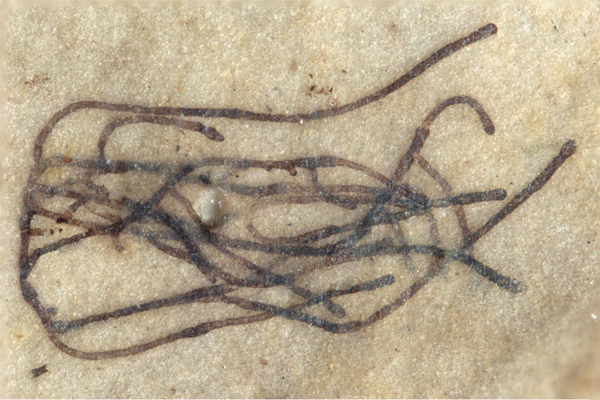New Research into One-billion-year-old Greens
One-billion-year-old Green Seaweeds
This week has seen the publication of a remarkable paper that documents the discovery of tiny one-billion-year-old fossils of green seaweeds that could be the ancestor of the first land plants.
Writing in the academic journal “Nature Ecology and Evolution”, the researchers from Virginia Tech (USA) and the Chinese Academy of Sciences, describe abundant millimetre-sized, multicellular fossils that were preserved in ancient marine sediments close to the city of Dalian in Liaoning Province (northern China).
Evidence of Ancient Green Seaweed

Picture credit: Virginia Tech
Proterocladus antiquus
The microscopic fossils, measuring around two millimetres in length are described as a new species of green algae (Proterocladus antiquus). The fossil material is interpreted as benthic (living on the sea floor) and members of the Chlorophyta Phylum, which means that these ancient marine plants were photosynthesising 1,000 million years ago and that the fossils are the oldest evidence of green seaweeds known to science.
Shuhai Xiao (Geosciences and Global Change Centre at Virginia Tech), one of the co-authors of the scientific paper commented:
“These new fossils suggest that green seaweeds were important players in the ocean long before their land-plant descendants moved and took control of dry land. The entire biosphere is largely dependent on plants and algae for food and oxygen, yet land plants did not evolve until about 450 million years ago. Our study shows that green seaweeds evolved no later than 1 billion years ago, pushing back the record of green seaweeds by about 200 million years. What kind of seaweeds supplied food to the marine ecosystem?”
Land Plants Evolved from Green Seaweeds
One of the theories proposed for the evolution of land plants is that they originated from marine chlorophytes. These plants adapted to a life on dry land, the scientists propose that these Chinese fossils represent the ancestors of modern land plants that we see today.
However, Xiao added that not all geobiologists agree with this hypothesis, the debate as to how land plants originated goes on. For example, some scientists think that green plants first evolved in freshwater environments before adapting to a terrestrial existence.
A Life Reconstruction of the Ancient Green Seaweed P. antiquus
Picture credit: Dinghua Yang/Virginia Tech
Different Types of Seaweed
Scientists have classified three main kinds of seaweed, commonly referred to by their predominant colour. There is brown (Phaeophyceae), green (Chlorophyta) and red (Rhodophyta). There are thousands of species of each kind. Rhodophyta (red seaweed), have a fossil record that also dates back to more than a billion years ago.
Xiao added:
“There are some modern green seaweeds that look very similar to the fossils that we found. A group of modern green seaweeds, known as siphonocladaleans, are particularly similar in shape and size to the fossils we found.”
Early Plant Fossils
The discovery of such an early photosynthetic plant represents a significant landmark in helping scientists to better understand the evolution and development of planetary ecosystems. Plants that photosynthesise are essential to the ecological balance of our planet. They produce carbon and oxygen through the process of photosynthesis and they are regarded as primary producers and comprise the basic components of most food chains.
It was Qing Tang of Virginia Tech, who discovered the micro-fossils of the ancient seaweeds, electron microscopy was used to spot the tiny specimens. To more easily see the fossils, mineral oil was dripped onto the fossil to create a strong contrast.
Tang commented:
“These seaweeds display multiple branches, upright growths, and specialised cells known as akinetes that are very common in this type of fossil. Taken together, these features strongly suggest that the fossil is a green seaweed with complex multicellularity that is circa 1 billion years old. These likely represent the earliest fossil of green seaweeds. In short, our study tells us that the ubiquitous green plants we see today can be traced back to at least 1 billion years.”
Everything Dinosaur acknowledges the assistance of a press release from Virginia Tech in the compilation of this article.
The scientific paper: “A one-billion-year-old multicellular chlorophyte” by Qing Tang, Ke Pang, Xunlai Yuan and Shuhai Xiao published in Nature Ecology and Evolution.
The Everything Dinosaur website: Visit the Everything Dinosaur Website.


